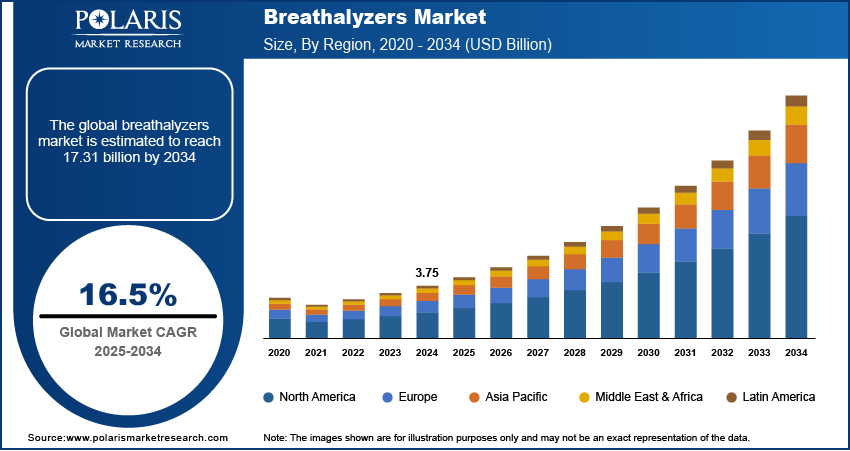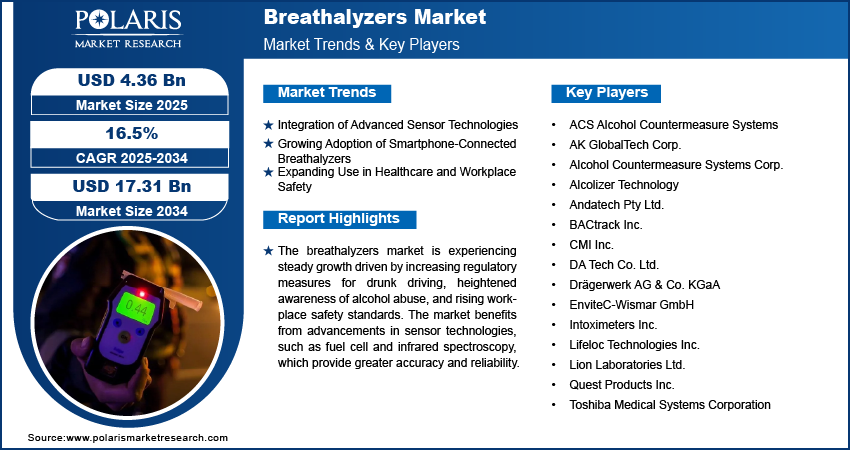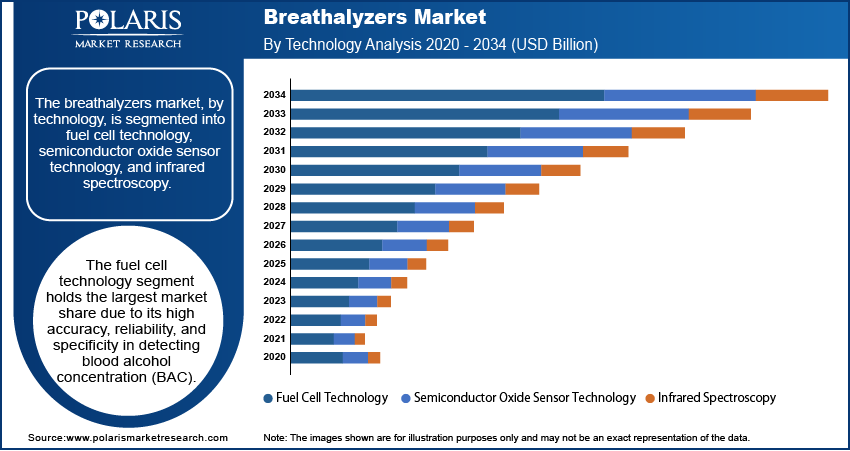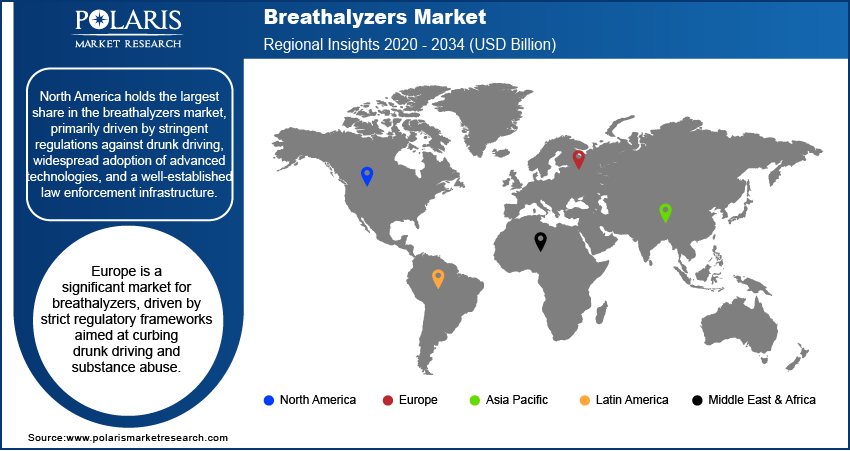
Breathalyzers Market Size, Share, Trends, Industry Analysis Report: By Technology (Fuel Cell Technology, Semiconductor Oxide Sensor Technology, and Infrared Spectroscopy), Application, and Region (North America, Europe, Asia Pacific, Latin America and Middle East & Africa) – Market Forecast, 2025–2034
- Published Date:Feb-2025
- Pages: 117
- Format: PDF
- Report ID: PM1747
- Base Year: 2024
- Historical Data: 2020-2023
Breathalyzers Market Overview
The global breathalyzers market size was valued at USD 3.75 billion in 2024. The market is projected to grow from USD 4.36 billion in 2025 to USD 17.31 billion by 2034, exhibiting a CAGR of 16.5% from 2025 to 2034.
The breathalyzers market focuses on the development, production, and sale of devices used to measure blood alcohol concentration (BAC) through breath analysis. These devices are widely utilized by law enforcement, workplace safety programs, and healthcare providers.

To Understand More About this Research: Request a Free Sample Report
The increasing enforcement of stringent drunk driving regulations, growing awareness of alcohol abuse, and the demand for non-invasive diagnostic tools are a few of the key factors driving the breathalyzers market growth. Emerging trends in the market include the integration of smartphone connectivity, advancements in sensor technology, and the rising adoption of personal breathalyzers for self-monitoring.
Breathalyzers Market Dynamics
Integration of Advanced Sensor Technologies
The adoption of advanced sensor technologies is transforming the breathalyzers market by enhancing device accuracy and reliability. Innovations such as fuel cell sensors and infrared spectroscopy are becoming standard, providing higher precision in detecting blood alcohol concentrations (BAC). Fuel cell-based breathalyzers, for example, are widely used in law enforcement due to their ability to provide stable and specific readings over time. A study by the National Highway Traffic Safety Administration (NHTSA) highlights that fuel cell sensors reduce the margin of error in BAC measurements by approximately 50% compared to traditional semiconductor sensors. This shift toward more accurate and reliable technologies is driving the adoption of professional-grade breathalyzers for broader applications.
Growing Adoption of Smartphone-Connected Breathalyzers
Smartphone connectivity is emerging as one of the major breathalyzers market trends, driven by the increasing use of mobile applications for personal health monitoring. Devices such as BACtrack and Alcohoot integrate with smartphones, offering users real-time BAC analysis and tracking features. These devices allow users to access historical data and even notify designated contacts in case of high BAC readings. According to a report by the National Institutes of Health (NIH), smartphone-compatible breathalyzers are becoming increasingly popular among individuals aged 25 to 40, who prioritize convenience and technology-driven solutions. This growing preference for smartphone-integrated devices highlights the rising demand for portable, user-friendly breathalyzers.
Expanding Use in Healthcare and Workplace Safety
Breathalyzers are witnessing growing adoption in healthcare and workplace safety, expanding beyond traditional law enforcement applications. In healthcare, breathalyzers are increasingly being used for non-invasive diagnostics of conditions such as bacterial infections and metabolic disorders. For example, researchers at the Mayo Clinic have explored the use of breathalyzer technology for detecting Helicobacter pylori, a bacterium associated with stomach ulcers, with a diagnostic accuracy exceeding 90%. Similarly, industries with stringent safety protocols, such as transportation and construction, are leveraging breathalyzers to ensure compliance with alcohol-free workplace policies. This diversification of applications is driving demand for tailored solutions across sectors.

Breathalyzers Market Segment Insights
Breathalyzers Market Assessment Based on Technology
The breathalyzers market, by technology, is segmented into fuel cell technology, semiconductor oxide sensor technology, and infrared spectroscopy. The fuel cell technology segment holds the largest breathalyzers market share due to its high accuracy, reliability, and specificity in detecting blood alcohol concentration (BAC). This technology is widely used in law enforcement and workplace safety applications, where precise measurements are critical. Fuel cell-based breathalyzers offer advantages such as long sensor life, reduced calibration needs, and minimal interference from substances like acetone, which can affect other sensor types. These attributes make them the preferred choice for professional-grade devices. Additionally, their compact size and affordability are contributing to their widespread adoption in both commercial and personal settings.
Infrared spectroscopy, while not as broadly implemented, is registering the highest growth in the market due to its advanced analytical capabilities and suitability for sophisticated applications. This technology is primarily used in high-end stationary devices, often deployed at checkpoints or in forensic labs, due to its ability to deliver highly accurate readings and analyze complex samples. Its rising adoption in healthcare diagnostics for non-alcohol-related conditions further highlights its versatility. Semiconductor oxide sensor technology, on the other hand, remains popular in personal breathalyzers for its cost-effectiveness, though it is typically associated with lower accuracy compared to other technologies. This segmentation reflects diverse technological preferences across various use cases and end-user industries.
Breathalyzers Market Evaluation Based on Application
The breathalyzers market, by application, is segmented into drug abuse detection, alcohol detection, and other applications. The alcohol detection segment holds the largest market share, driven by its extensive use in law enforcement, transportation, and personal monitoring. Increasing government regulations against drunk driving, along with stringent workplace safety policies, have significantly boosted the demand for alcohol detection devices. These devices are particularly favored for their ability to provide real-time and accurate measurements of blood alcohol concentration (BAC). The widespread deployment of alcohol detection breathalyzers in routine traffic checks and alcohol control programs further solidifies their dominance in the market.
The drug abuse detection segment is witnessing the highest CAGR, fueled by the rising prevalence of substance abuse and the growing need for early and non-invasive diagnostic tools. Governments and private organizations are increasingly adopting drug detection breathalyzers to address concerns related to workplace safety and public health. These devices are becoming integral to drug-testing protocols, especially in sectors such as law enforcement, rehabilitation, and healthcare. The expanding use of drug detection breathalyzers in identifying illicit substances like THC and opioids positions this segment as a key area of development within the market. Other applications, including medical diagnostics and disease monitoring, are also gaining traction, highlighting the broadening scope of breathalyzer technologies.

Breathalyzers Market Regional Analysis
By region, the study provides market insights into North America, Europe, Asia Pacific, Latin America, and the Middle East & Africa. North America holds the largest share in the breathalyzers market, primarily driven by stringent regulations against drunk driving, widespread adoption of advanced technologies, and a well-established law enforcement infrastructure. The region benefits from high awareness regarding road safety and substance abuse prevention, supported by initiatives such as zero-tolerance policies and mandatory alcohol testing programs. The US, in particular, is a major contributor to the market due to significant investments in research and development, as well as the increasing demand for personal breathalyzers among consumers. Additionally, the presence of leading manufacturers and favorable government initiatives boost the regional market dominance.
Europe is a significant market for breathalyzers, driven by strict regulatory frameworks aimed at curbing drunk driving and substance abuse. Countries such as Germany, France, and the UK have implemented rigorous alcohol testing programs, contributing to the widespread adoption of breathalyzers. The region also benefits from high consumer awareness and the growing use of portable breathalyzers for personal monitoring. Additionally, advancements in sensor technology and increasing applications in healthcare diagnostics support market growth in Europe.
The Asia Pacific breathalyzers market is witnessing rapid growth, fueled by rising incidences of road accidents linked to alcohol consumption and increasing government initiatives to enforce road safety laws. Emerging economies like India and China are seeing a surge in demand for cost-effective and portable breathalyzers, especially in urban areas. Moreover, the expansion of healthcare infrastructure in the region is driving the use of breathalyzer technology for medical diagnostics. The increasing adoption of workplace safety protocols in industrial sectors also contributes to the regional market growth.

Breathalyzers Market – Key Players and Competitive Insights
Key players active in the breathalyzers market include Drägerwerk AG & Co. KGaA, Intoximeters Inc., BACtrack Inc., Lifeloc Technologies Inc., Quest Products Inc., Alcolizer Technology, Andatech Pty Ltd., Lion Laboratories Ltd., Alcohol Countermeasure Systems Corp., EnviteC-Wismar GmbH (a subsidiary of Honeywell International Inc.), AK GlobalTech Corp., CMI Inc., DA Tech Co. Ltd., ACS Alcohol Countermeasure Systems, and Toshiba Medical Systems Corporation. These companies focus on developing breathalyzers with advanced features, catering to both professional and personal use cases.
The competitive landscape of the breathalyzers market is shaped by product differentiation, technological innovation, and geographical reach. Companies like Drägerwerk AG & Co. KGaA and Intoximeters Inc. dominate law enforcement and workplace safety segments due to their highly accurate and durable devices. BACtrack Inc. and Lifeloc Technologies Inc. are well-positioned in the consumer and portable device segments, leveraging user-friendly designs and smartphone connectivity. Regional players like Alcolizer Technology in Australia and Andatech Pty Ltd. in Asia Pacific cater to local markets with cost-effective solutions tailored to regional requirements.
Insights into the market reveal that innovation in sensor technologies and expanding applications in healthcare are key areas of focus for market players. Partnerships with government bodies for public safety initiatives and investments in research and development to enhance product performance are common strategies. Additionally, the shift towards non-invasive diagnostics and integration with digital platforms for real-time monitoring offers opportunities for growth and differentiation. Companies are increasingly competing on accuracy, reliability, and affordability to capture diverse consumer and institutional demand globally.
Drägerwerk AG & Co. KGaA is a major player in the breathalyzers market, providing devices for both professional and personal use. The company is known for its fuel cell-based breathalyzers, which are widely used by law enforcement and in workplace safety programs. Drägerwerk focuses on offering high-precision devices that meet regulatory standards, and its breathalyzers are commonly used in countries with strict alcohol testing policies.
BACtrack Inc. is another significant player in the market, known for its wide range of personal breathalyzers. The company’s products are popular for personal use, allowing consumers to monitor their alcohol levels conveniently. BACtrack has positioned itself as a leader in portable breathalyzers with smartphone connectivity.
List of Key Companies in Breathalyzers Market
- ACS Alcohol Countermeasure Systems
- AK GlobalTech Corp.
- Alcohol Countermeasure Systems Corp.
- Alcolizer Technology
- Andatech Pty Ltd.
- BACtrack Inc.
- CMI Inc.
- DA Tech Co. Ltd.
- Drägerwerk AG & Co. KGaA
- EnviteC-Wismar GmbH (a subsidiary of Honeywell International Inc.)
- Intoximeters Inc.
- Lifeloc Technologies Inc.
- Lion Laboratories Ltd.
- Quest Products Inc.
- Toshiba Medical Systems Corporation
Breathalyzers Industry Developments
- In October 2024, Drägerwerk announced the release of a new portable alcohol tester that aims to improve the ease of use and accuracy of its devices for police officers and other professionals.
- In September 2024, BACtrack released an updated version of BACtrack Mobile. The updated version incorporates advanced Bluetooth features that enable users to sync their breathalyzer readings with a mobile app for real-time tracking.
Breathalyzers Market Segmentation
By Technology Outlook
- Fuel Cell Technology
- Semiconductor Oxide Sensor Technology
- Infrared Spectroscopy
By Application Outlook
- Drug Abuse Detection
- Alcohol Detection
- Other Applications
By Regional Outlook
- North America
- US
- Canada
- Europe
- Germany
- France
- UK
- Italy
- Spain
- Netherlands
- Russia
- Rest of Europe
- Asia Pacific
- China
- Japan
- India
- Malaysia
- South Korea
- Indonesia
- Australia
- Vietnam
- Rest of Asia Pacific
- Middle East & Africa
- Saudi Arabia
- UAE
- Israel
- South Africa
- Rest of Middle East & Africa
- Latin America
- Mexico
- Brazil
- Argentina
- Rest of Latin America
Breathalyzers Market Report Scope
|
Report Attributes |
Details |
|
Market Size Value in 2024 |
USD 3.75 billion |
|
Market Size Value in 2025 |
USD 4.36 billion |
|
Revenue Forecast by 2034 |
USD 17.31 billion |
|
CAGR |
16.5% from 2025 to 2034 |
|
Base Year |
2024 |
|
Historical Data |
2020–2023 |
|
Forecast Period |
2025–2034 |
|
Quantitative Units |
Revenue in USD billion and CAGR from 2025 to 2034 |
|
Report Coverage |
Revenue Forecast, Market Competitive Landscape, Growth Factors, and Trends |
|
Segments Covered |
|
|
Regional Scope |
|
|
Competitive landscape |
|
|
Report Format |
|
|
Customization |
Report customization as per your requirements with respect to countries, regions, and segmentation. |
How is the report valuable for an organization?
Workflow/Innovation Strategy
The breathalyzers market has been segmented into detailed segments of technology and application. Moreover, the study provides the reader with a detailed understanding of the different segments at both the global and regional levels.
Growth/Marketing Strategy
The growth strategy in the breathalyzers market revolves around technological advancements, geographic expansion, and diversification of applications. Companies are focusing on integrating features such as smartphone connectivity, enhanced sensor accuracy, and compact designs to appeal to a broader consumer base. Partnerships with law enforcement agencies, workplace safety organizations, and healthcare providers are key to market penetration. Additionally, targeted marketing campaigns emphasizing personal safety and regulatory compliance are driving consumer adoption. Investments in R&D for non-invasive diagnostics and customization for emerging markets further support sustained growth.
FAQ's
? The breathalyzers market size was valued at USD 3.75 billion in 2024 and is projected to grow to USD 17.31 billion by 2034.
? The market is projected to register a CAGR of 16.5% from 2025 to 2034.
? North America had the largest share of the market in 2024.
? Key players active in the breathalyzers market include Drägerwerk AG & Co. KGaA, Intoximeters Inc., BACtrack Inc., Lifeloc Technologies Inc., Quest Products Inc., Alcolizer Technology, Andatech Pty Ltd., Lion Laboratories Ltd., Alcohol Countermeasure Systems Corp., EnviteC-Wismar GmbH (a subsidiary of Honeywell International Inc.), AK GlobalTech Corp., CMI Inc., DA Tech Co. Ltd., ACS Alcohol Countermeasure Systems, and Toshiba Medical Systems Corporation.
? The fuel cell technology segment accounted for the largest market share in 2024.
? The alcohol detection segment accounted for the largest market share in 2024.
? Breathalyzers are handheld or stationary devices used to measure the concentration of alcohol or other substances in a person's breath. These devices work by analyzing the chemical composition of exhaled breath to estimate blood alcohol concentration (BAC) or detect the presence of drugs or certain medical conditions. Commonly used by law enforcement for detecting drunk driving, breathalyzers are also utilized in workplace safety programs, personal alcohol monitoring, and healthcare diagnostics. They are valued for being non-invasive, portable, and capable of providing quick and reliable results.
? A few key trends in the breathalyzers market are described below: Integration of Smartphone Connectivity: Increasing adoption of devices that connect to smartphones for real-time BAC tracking, data storage, and sharing. Advancements in Sensor Technologies: Development of more accurate and durable sensors, such as fuel cell and infrared spectroscopy, improving device performance. Portable and Compact Designs: Growing demand for lightweight, easy-to-carry personal breathalyzers for consumer use. Expanding Applications: Use of breathalyzers beyond alcohol detection, including drug abuse detection and healthcare diagnostics.
? A new company entering the breathalyzers market could focus on developing innovative, user-friendly devices with enhanced smartphone integration for real-time BAC tracking and data sharing. By incorporating advanced sensor technologies, such as fuel cell or infrared spectroscopy, it could differentiate itself with higher accuracy and reliability. Additionally, targeting emerging applications, such as drug abuse detection and non-invasive medical diagnostics, could offer a competitive edge. Expanding into regions with growing road safety initiatives and consumer awareness of personal health could also drive market adoption. Lastly, competitive pricing and strong customer support would help build brand loyalty and capture market share.
? Companies manufacturing, distributing, or purchasing breathalyzers and related products, and other consulting firms must buy the report.
